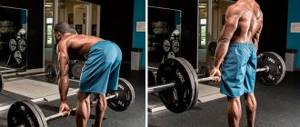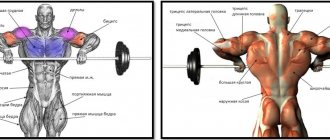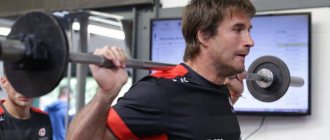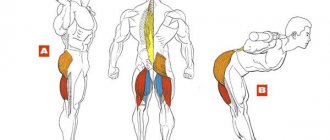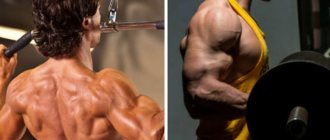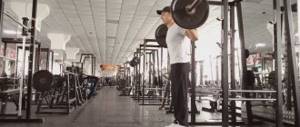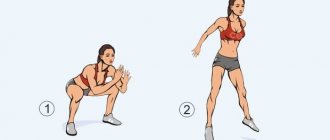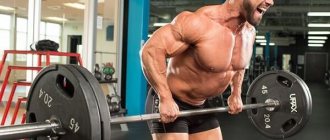During the off-season, training for a strongman is similar to training for a bodybuilder, the tasks and goals partly coincide - development of lagging muscle groups, general gain of muscle mass, only as he approaches the competition, the arsenal of additional exercises for a strongman decreases/changes, weights increase, the number of repetitions decreases.
The higher the class of a strongman, the more clearly the division of the training cycle into phases is expressed, the wider his arsenal of auxiliary exercises should be. Auxiliary exercises in deadlifting can be divided into two main groups.
- The first group includes those exercises that powerlifters will perform everywhere - they are aimed at “pumping up” the main muscle groups.
- The second group includes exercises used to level out “weak” areas and improve technique.
The training cycle mainly consists of three phases
- The “pumping” phase - this phase mainly comes down to gaining muscle mass
- Intermediate phase - the phase of transition from “pumping” to working with weights by percentage (increasing strength endurance, improving technique and speed-strength qualities)
- Direct preparation for competitions - classic power percentage schemes
It’s quite easy to identify weak points; break the movement into three (or more) phases:
- You have a bad takeoff - use special exercises (most likely you have a weak lower back or legs (depending on the specifics of your technique)).
- The problem is that you cannot lift the barbell with your knees - most likely you have problems with technique or weak “pillars” and the center of your back)
- Problems with “reaching” – weak trapezius or center of the back.
- The barbell falls out of your hands - weak hands
Assistance exercises for squats
There are a number of possible assistance exercises that can help you achieve good results in squats. Of course, it is quite possible that not all of them will suit you personally, but knowing what we are talking about and having all the necessary information for experiments will be very useful.
1. The most basic of the auxiliary exercises is classic squats or technical squats. Moreover, your squat technique in training should be identical to the technique in competitions. As you yourself understand, training in one style and competing in a completely different style is not the right decision.
2. Next. Half squats. These squats can be performed on a bench or without one. This auxiliary exercise is designed to develop in you a kind of “habit” of heavy weights, as well as to develop the technique of removing the barbell from the racks. The technique here is the same as in classic squats, only the depth of half squats is a quarter of the depth of regular squats or more. It all depends on the weight of the barbell. To perform an overload, that is, holding the barbell in the starting position for squats, you will need two assistants to help you remove the barbell from the racks. In this position, you need to withstand the load for at least 10 seconds. In this case, the most important thing will be to control your chosen weight. This assistance exercise will prepare your body for submaximal weights. This will require a weight that is approximately 110%-150% of your maximum squat weight.
3. Another effective assistance exercise is slow squats. Again, the technique is similar to classic squats, but the tempo of the exercise is much slower. There are two options here. Either you perform a slow squat (for 3-5 seconds, and the same slow return to the starting position), or you perform a slow squat and a fairly quick rise. This technique is also very helpful in developing good technique for subsequent squats with large weights.
4. Another option is holding squats. They are performed in the same way as the classic ones, only with the addition of some pauses of 1-3 seconds.
5. There is also the option of squats with a delay specifically in the saddle. These squats are most suitable for squats with a barbell, when it is placed higher on the trapezius. The legs should be placed slightly narrower than usual to provide good support at the lower point on the shin. The tempo of squats remains normal, but you should pause at the bottom for 2-3 seconds. While sitting, it would be appropriate to slightly relax your upper back and, as it were, “lie down” with your chest on your knees. The sed, accordingly, will be as deep as possible. This position will ideally load the long back muscles, especially their middle parts, as well as the hips.
If you are a lover of active recreation and prefer to see everything on your own than to sit on a yarn near the hotel, then you can try hiking in the Crimea and the Carpathians. To do this, you need to study and choose the appropriate route and conditions.
Similar articles:
- Crunching in the knees when squatting
- Squat technique
- Squats: benefit or harm
- Sumo squats
- Overhead squats
Did you like the material? Share the link with others!
Do you want to be the first to know about site updates?
(0 Votes)
Add a comment
Classification of exercises depending on the stage of preparation
Phase 1 - pitching
- Shrugs (with barbell or dumbbells)
- Squats on a low bench
- Squats with a barbell on hands
- Leg press
- Leg extensions
- Leg Curls
- Bent-overs with a barbell
- Bent-overs with a barbell while sitting
- Deadlift
- Hyperextension
- Pulling the block to the chest with various grips (reverse-straight, narrow-wide)
- Bent-over barbell row with medium or wide grip
- Exercise bike (maximum intensity)
Phase 2 - transition from pitching to percentage schemes
- Shrugs (with barbell or dumbbells)
- "Negative" cravings
- Squats on a low bench
- Deadlift in a power rack
- Barbell pull out of the pit
- Squats with a barbell on hands
- Leg press
- Leg Curls
- Bent-overs with a barbell
- Bent-overs with a barbell while sitting
- Deadlift
- Hyperextension
- Pulling the block to the chest with various grips (reverse-straight, narrow-wide)
- Bent-over barbell row with medium or wide grip
- Exercise bike (maximum intensity)
Phase 3 - preparation for competitions
- Shrugs (with barbell or dumbbells)
- Deadlift in a power rack
- Barbell pull out of the pit
- Leg press
- Leg Curls
- Bent-overs with a barbell
- Bent-overs with a barbell while sitting
- Deadlift
- Hyperextension
- Pulling the block to the chest with various grips (reverse-straight, narrow-wide)
- Bent-over barbell row with medium or wide grip
- Exercise bike (maximum intensity)
Deadlift Variations
Romanian deadlift
To begin the movement, stand with the barbell in your hands rather than on the floor and lower until you feel a gentle stretch in your hamstrings to build flexibility as well as strength, power, and control in these often-overlooked leg muscles. There is no need to lift a lot of weight for the Romanian deadlift to be effective, so start small.
Trap bar pull
You may also find this version labeled as a hex bar row, due to the hexagonal shape of the barbell used. This is an effective version of the classic row, with the handles on the side forcing you to retract your shoulder blades and engage your latissimus dorsi. It's great for quickly building back strength and doesn't put as much pressure on your lower back as other rowing options since gravity isn't pulling you forward.
Sumo deadlift
Place your feet wider and grip the barbell with a slightly narrower grip than you would with a regular deadlift. Use significantly lighter weights as this exercise targets the muscles in your hamstrings, making it a great builder for strong legs.
Wide grip deadlift
Grip the barbell with a wider grip to give more attention to your upper back (trapezius) muscles. Rise up slowly to avoid straining your back.
Rack deadlift
If you find that the range of motion of a conventional deadlift is too difficult for you, start by lifting the barbell from a block or rack. This is a good variation to start with until you become more confident with the movement because it reduces the stress on your lower back.
Selection of basic exercises to work on “weak points”
Exercises are listed in descending order of effectiveness
Bad lead
- Hyperextension
- Deadlift
- Barbell pull out of the pit
- Bent-overs with a barbell
- Bent-overs with a barbell while sitting
- Leg press
- Squats with weight between benches
- Squats on a low bench
- Exercise bike (maximum intensity)
“Stopper” at a level below the knee 5-10 cm
- Deadlift in a power rack
- Hyperextension
- Deadlift
- Bent-overs with a barbell
- Bent-overs with a barbell while sitting
Problems with “reaching”
- Deadlift in a power rack
- Shrugs (with barbell or dumbbells)
- Bent-over barbell row with medium or wide grip
- Pulling a block to the chest with various grips (reverse - straight, narrow - wide)
The barbell falls out of your hands
- Holding the barbell for a while
- Static weight hold
You can see that exercises such as hyperextensions, deadlifts, deadlifts, and barbell rows should be practiced constantly.
Deadlift in a power rack
The exercise is aimed at improving technique and eliminating problems when passing the sticking point.
The higher your dead center is from the floor, the more barbell weight you should use, up to significantly exceeding your maximal maximum.
In addition, this exercise allows you to create extreme tension in the entire body, shockingly “bombs” the entire back and with the correct technique of the legs.
The recommended number of repetitions is 2-4 in 2-5 approaches.
Barbell pull out of the pit
This exercise is aimed at improving the lift (the bar is at the level of your ankles)
The recommended number of repetitions is 3-5 in 3-5 sets.
Squats with a barbell on hands
This exercise is aimed at improving technique and picking.
The weight of the bar should be negligible
The recommended number of repetitions is 4-8 in 3-6 approaches.
Squats on a low bench
This exercise is aimed at improving technique and picking.
The weight of the bar should be negligible
The recommended number of repetitions is 4-8 in 3-5 sets.
"Negative" cravings
The exercise is aimed at improving technique and strengthening ligaments.
A pronounced exercise that combines a very long negative phase (~10 seconds) and a very fast positive one - on the count of 6 you should go through a right angle, on the count of 10 you should be in the “full squat” position (your partner should count), try to get up as quickly as possible .
The recommended number of repetitions is 4-8 in 3-5 sets.
Holding the barbell for a while
The exercise is aimed at strengthening the hands.
The recommended number of repetitions is 4-8 in 3-6 approaches.
Static weight hold
The exercise is aimed at strengthening the ligaments of the hands - use your fingertips to cling to a thin beam (or at least a crossbar) and endure as long as you can.
The exercise should be done at the slightest free time (including between approaches).
Leg press
The exercise perfectly works the quadriceps, which are so necessary for traction.
The recommended number of repetitions is 4-8 in 3-6 approaches.
Squats with weight between benches
The exercise perfectly works the quadriceps, which are so necessary for lifting.
The recommended number of repetitions is 4-8 in 3-6 approaches.
Leg Curls
The exercise perfectly develops the hamstrings.
The recommended number of repetitions is 6-15 in 3-5 approaches.
Hyperextension
The exercise is aimed at developing the longitudinal muscles of the back (“pillars”).
The recommended number of repetitions is 5-10 in 3-6 approaches.
Bent-overs with a barbell
The exercise is aimed at developing the longitudinal muscles of the back (“pillars”).
The recommended number of repetitions is 5-8 in 3-5 approaches.
Bent-overs with a barbell while sitting
The exercise is aimed at developing the longitudinal muscles of the back (“pillars”).
The recommended number of repetitions is 5-8 in 3-5 approaches.
Deadlift
A powerful basic exercise that comprehensively pumps the hamstrings and longitudinal muscles of the back.
The recommended number of repetitions is 6-8 in 3-6 approaches.
Bent-over barbell row with medium or wide grip
The exercise pumps up the center (center of the lats) of the back.
The recommended number of repetitions is 5-10 in 3-6 approaches.
Pulling the block to the chest with various grips (reverse - straight, narrow - wide)
The exercises are aimed at comprehensively working out the back muscles.
The recommended number of repetitions is 6-8 in 3-4 sets.
Exercise bike (maximum intensity)
In this context (of this article), the exercise is aimed at improving the speed-explosive qualities of the quadriceps.
20-40 minutes of several series (alternating calm riding with maximum intensity) or 5-10 minutes of maximum intensity.
Shrugs (with barbell or dumbbells)
This exercise hits the trapezius, the calling card of a powerlifter.
The recommended number of repetitions is 8-20 in 2-4 approaches.
Assistance Exercises for Squats and Deadlifts
Now let's talk about auxiliary or additional exercises that help increase results in deadlifts and squats. For the preparatory period that we are talking about, you can collect a whole arsenal of excellent exercises that will contribute to your progress. Of course, the division into squats and deadlifts is conditional, because almost everywhere the legs and back are involved. There is a division into training different phases of movement. For example, sitting in a competition stance, on a platform 15-20 cm high, helps strengthen and stretch the ligamentous apparatus, sometimes elementary stiffness of the joints does not allow you to “sag” in the competition, especially with heavy weights. Sits on the middle stand, practicing the fall from the “dead” corner, where the equipment does not work and only due to the starting force, acceleration and correct technique you can get up from the stand. And how can a cabinet help! This is about mastering a new suit and practicing the correct saddle technique. Very often on the forum and in private conversations you hear, they say, you haven’t mastered the new suit yet. Here, a medium-height cabinet is your faithful friend. The scheme is simple, you put on a suit belt, without bandages. If your best result is 150 kg, then the barbell is 80-90 kilos. Place your feet in a competition stance and sit on the stand, trying to keep your back straight and make sure that your knees and shins do not run forward. Another little hint: place the cabinet at an angle and sit not on the front corner, but in the middle of the cabinet. I'm confident that 3-5 sets will give you a clearer picture of what you're doing, and the light weight will give you the opportunity to pay attention to your squat technique rather than whether you get up or not.
Leg presses, we practically don’t do them, are superfluous, it’s better if you have a back injury or want to pump up your legs, work out a breakdown in a deadlift or squat, then squats with a weight on your belt. Great leg exercise. Bending with a barbell on your back in a wide stance: good work on the back extensors, the back of the thigh, and the gluteal muscles. How to squat on a machine: to be honest, most of the designs do not suit me, they are very dangerous for the knees, because many people start to hang exorbitant weights and sit down in a full squat, the platform is often narrow and short, you can’t get into a competition stance! Very good for developing squats, speed squats or “barbell jumps” from a full squat. The main task of this exercise is to perform 8-10 repetitions as quickly as possible with a light weight of 40-45% of the maximal maximum, without fixing at the bottom or at the top, at speed, developing maximum effort from bottom to top. Try it, just hold your back rigidly, and press the barbell tightly against your back with your hands, otherwise it won’t be pleasant to hit the bar on your spine! In the preparatory period, to improve results with deadlifts, jerk shrugs with wrist straps for 8-10 repetitions are suitable, the weight is as heavy as possible for these repetitions. Holding a barbell is done like this: in a power rack after warming up or shrugging, hang the maximum weight on the barbell and after lifting it off the supports, try to hold it in your hands for as long as you can, well, 20-30 seconds.
The preparatory period is necessary to build strength; breakthroughs or records in a competitive style are not needed at times. Do at least 5-6 repetitions in all exercises for heavy ones, more repetitions and lighter weights for speed and medium-light workouts. You can set records in the assistance exercises discussed above. Very often we do not use the competitive movement as the main one at all, making do with the arsenal listed above during training.
Competition cycle
What period of time should I take for a competition cycle? I usually take 8-9 weeks. The principles of constructing the training process are the same: training is planned according to the nature of the load: light-recovery and heavy. Schematically, the entire cycle looks like this: heavy bench training, two days of rest, heavy leg training, two days of rest, light bench training, two days of rest, light leg training, two days of rest, and the training cycle repeats. Let's start making a plan.
We count 8-9 weeks from the day of the competition and begin to plan out the workouts. It turns out that according to the pattern of alternating heavy-light training, we have about 10 of them, in the bench press and squats (the deadlift is included in the squats), of which 5 are heavy and 5 are light.
Now the rule that I try to adhere to is complete rest 4-7 days before the start. Why such a run-up is 4-7 days, everything is individual, this is the weight category, and personal recovery and how the athlete is able to cope with his emotions before the competition. It’s easier to recover after the bench press, so the last training session for this movement before the competition is light, two days before the bench press we plan the last light squats. After the last bench press, 4-7 days of proper rest with a bath, lying on the couch, walks in nature, etc.
Now that you have drawn up a training plan, broken down by numbers based on the date of the competition, we begin to plan the load. There are 5 heavy workouts, they should include both walking into a full squat and approaching the walking. Let's start in order.
For a hard workout, we usually take out all the equipment that is available. For the bench press, a competition jersey, the one you will wear in competitions! For squats, hard bandages, briefs, overalls, an erector, whoever has what. You need to start with “press” training! After a heavy squat and deadlift, two days later, it is very difficult to show real results in the bench press! Therefore, the bench press comes first.
So, here is a training program to get into peak shape at competitions.
